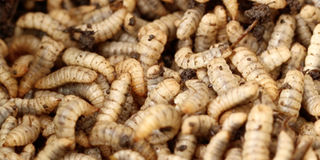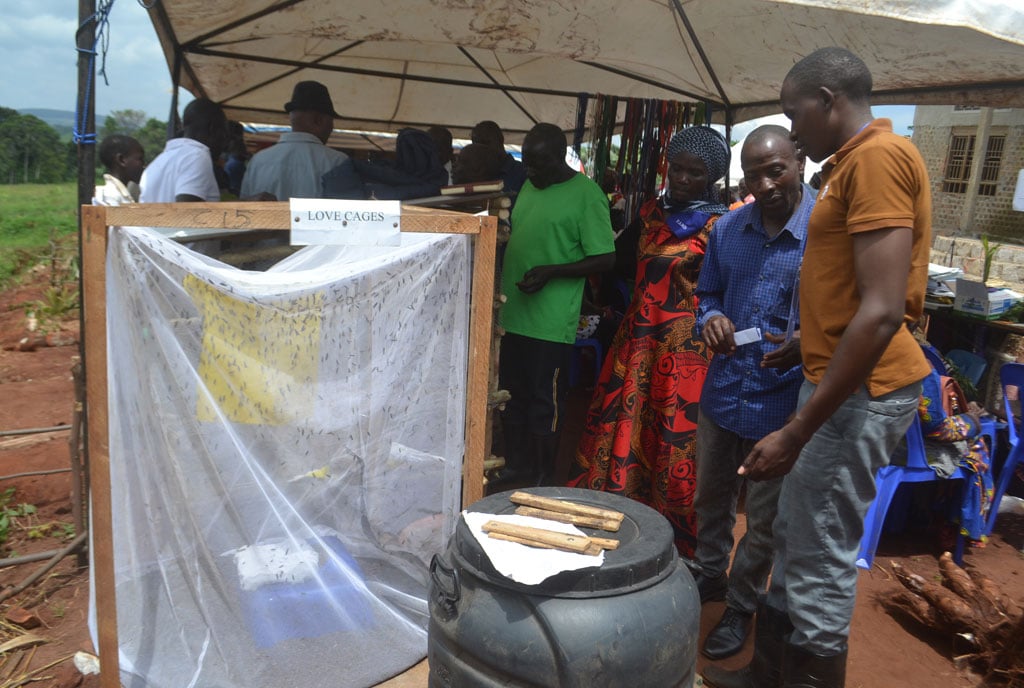Prime
Black soldier flies will help save up to 40 per cent on feed

Black Soldier Fly pupae has numerous advantages including cutting costs of animal feeds. Photo | Courtesy
What you need to know:
- Black soldier flies are small, harmless insects that have the potential to provide promising solutions to two of modern agriculture’s growing problems: the high cost of animal feed and the disposal of large amounts of animal waste. Many farms now operate as linear systems, purchasing animal feed and then paying to eliminate waste from farm animals.
With fertiliser prices more than doubling in the country in recent times due to the war in Ukraine that has affected every sector of society, the larvae of the black soldier fly is a greener and cheap alternative for local farmers.
The Food and Agriculture Organisation (FAO)’s Animal Feed Resources Information System highlights the use of insects as animal and fish feed, including insects such as the desert locust, common housefly maggots and domesticated silkworm. However, many other insect species may also be well suited to industrial-scale feed production, such as beetles and weevils.
Derrick Mununuzi, an aquaculture technologist at Rwebitaba Zonal Agricultural Research and Development Institute (ZARDI), has noted during the Farm Clinic held at the station that researchers have put emphasis on Black soldier fly larvae (BSF) as a protein source in fish farming. The National Fisheries Resources Research Institute (NaFIRRI) is taking a lead role in sustainable BSF production.
“Black Soldier Fly larvae have numerous advantages and the mere fact that fish meal and soy cake are increasingly becoming very expensive, the Black Soldier Flies are a viable option in cutting production costs. It should be noted that feeds make up roughly 70 percent of the cost of farming and any solution tackling such an issue needs to be taken seriously. BSF are a lot more affordable. They grow on organic waste and within two weeks you can harvest them,” Mununuzi said.
Nutritive
Simply put, insects are natural food sources for many fish and poultry. Free-range chickens, for example, can be found picking worms and larvae from the topsoil and litter where they walk. There is a reason, too, why maggots are used as fish bait in recreational fishing. Given insects’ natural role as food for a number of farmed livestock species, it is worth reconsidering their role as feed for specific poultry and fish species.
The dry weight of Black Soldier Fly larvae contain up to 50 percent crude protein, up to 35 percent lipids and have an amino acid profile that is similar to that of fishmeal.
Mununuzi explains that fish fed with BSF-based feed were 23 percent heavier than those fed with conventional feed. Performance studies in catfish revealed that a 37 percent higher growth rate and 23 percent higher weight gain was achieved from BSF-based feed.
In poultry, performance studies show a 20 percent replacement of fishmeal in conventional feed with BSF resulted in 53 percent egg production and improved quality.
For Mununuzi, using BSF as feed has resulted in about a 40 percent increase in earnings.
Black soldier fly larvae (BSF) will eat nearly any kind of organic waste ranging from animal waste to food scraps. As the BSFL mature, they grow into ½-inch-long grubs, at which point they climb out of their food source and turn into pupae. The pupae can immediately be fed to chickens, fish or pigs and are a good source of protein. They can also be dried and processed into feed for use at a later time. Small composting operations also allow them to turn into flies and breed, propagating the population.
Food security
Business models for scaling insect-based protein feed in poultry and pig farming and aquaculture in Africa are currently gaining momentum.
The goal is to help alleviate poverty, promote food security and improve the overall health status of smallholder farmers.
The International Centre of Insect Physiology and Ecology (icipe), for instance, researched more than 28 insect species, including locusts and crickets, before settling on the BSF larvae as the best way forward.
Dutch startup Marula Proteen and the Centre for Insect Research & Development (CIRD) in Kawanda are the go-to places on BSF with a mission is to use insect science for sustainable development.
Dr Deborah Ruth Amulen, who established CIRD in 2021 said in a recent interview with Seeds of Gold that: “Black Soldier Flies are exceptional”.
The manure from the waste generated by the flies, mixed with organic waste and animal droppings, is safe to the soil and much cheaper compared to inorganic fertilisers whose prices have soared.
Tommie Hooft, director at Marula Proteen notes: “The fertiliser produced by the black soldier flies is full of healthy microbes that provide essential nutrients like nitrogen, phosphorous and potassium” to plants, making it an excellent option for farmers”.
Turning Waste into Value
In 2011, combined world feed production was estimated at 870 million tonnes. The Food and Agriculture Organisation (FAO) estimates that production will have to increase by 70 percent to be able to feed the world in 2050, with meat outputs (poultry, pork and beef) expected to double.
A major constraint to further development are the prohibitive costs of feed, including meat meal, fishmeal and soybean meal, which represent 60–70 percent of production costs.
Another problem is manure disposal, which is becoming a serious environmental problem; it is not uncommon for large amounts of manure to be stockpiled in open-air lots, swarming with flies.
In Kampala City alone, only 40 percent of the waste is collected. The rest ends up in the environment.
An alternative and sustainable proteins source is an issue of major importance and that is how BSF comes in.
How it works
The BSF eggs are placed in tent-like structures along with organic waste where they incubate for three days and then hatch. They eat nearly any kind of organic waste such as jackfruit, potato waste, and over-ripe avocados are used. The larvae begin feeding on the waste immediately.
In the larvae stage, the BSF transforms waste into high-quality protein which can be used as an alternative protein additive in animal feed, translating into an inexpensive, clean and sustainable food source—especially important as farmers, along with global economies, struggle to recover from the financial impact of the Covid-19 pandemic, including food shortages.
They grow over about 14 days and then all but 10 to 20 percent are harvested into feed. The remaining BSF perpetuate the colony. Within two weeks, they pass through the pupae stage before becoming flies. The flies live for about 10 to 16 days more on a diet of water only, and during that time they lay 500-plus eggs in a single batch that begin the process again.
The leftover organic frass fertiliser can be sold as an additional value-added product or used in gardens as manure.
Turning waste into a higher value product is a great contribution to global sustainability and climate-smart agriculture.
Requirements
All they need is a warm environment, some water and a place to lay eggs. Once the larvae is five days old, they are sold to farmers that keep them for a fortnight and get fertiliser from the manure the flies have been feeding on.
BSFL do not survive well in direct light or in extreme dry or wet conditions. They prefer to be 8- 9 inches deep in their food source. If they are too far below the surface, they will perform little bioconversion. Female flies avoid any sites that are anaerobic when trying to lay eggs.




